Business Law: Contract and Tort Law Principles Assignment
VerifiedAdded on 2020/04/01
|8
|2615
|108
Homework Assignment
AI Summary
This assignment solution delves into the core principles of Australian contract law, examining the essential elements required for a legally binding agreement, such as agreement, consideration, capability, intention, and certainty. It differentiates between oral and written contracts, highlighting the advantages and disadvantages of each. The solution also explores formal contracts, distinguishing between contracts of record and contracts by deed. Furthermore, the assignment addresses the concept of vicarious liability, particularly in the context of principal-agent and employer-independent contractor relationships, clarifying the legal distinctions and liabilities associated with each. References to relevant legal scholars and case studies are included to support the analysis.

Running head: CONTRACT 0
Business Law Assignment
Business Law Assignment
Paraphrase This Document
Need a fresh take? Get an instant paraphrase of this document with our AI Paraphraser
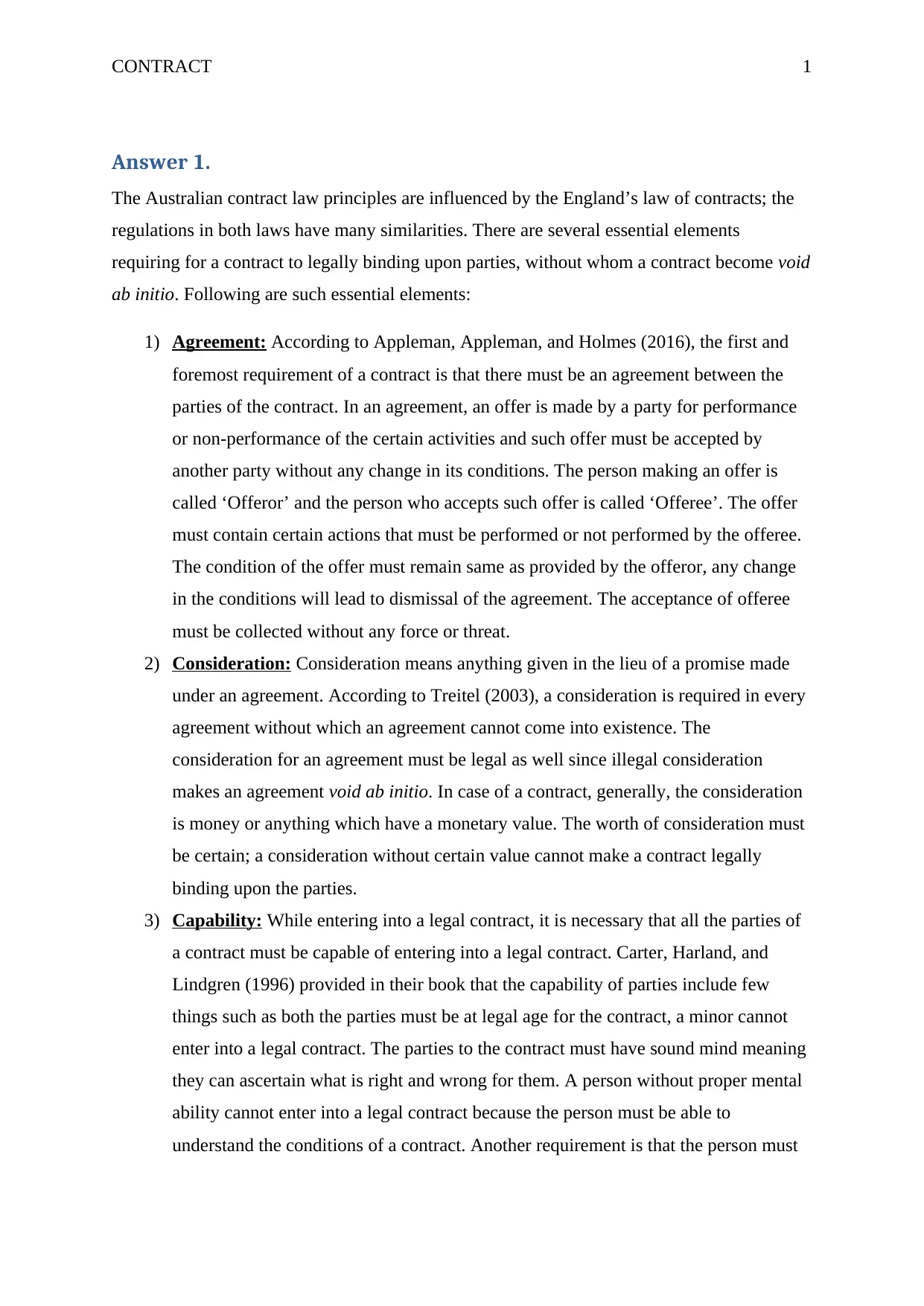
CONTRACT 1
Answer 1.
The Australian contract law principles are influenced by the England’s law of contracts; the
regulations in both laws have many similarities. There are several essential elements
requiring for a contract to legally binding upon parties, without whom a contract become void
ab initio. Following are such essential elements:
1) Agreement: According to Appleman, Appleman, and Holmes (2016), the first and
foremost requirement of a contract is that there must be an agreement between the
parties of the contract. In an agreement, an offer is made by a party for performance
or non-performance of the certain activities and such offer must be accepted by
another party without any change in its conditions. The person making an offer is
called ‘Offeror’ and the person who accepts such offer is called ‘Offeree’. The offer
must contain certain actions that must be performed or not performed by the offeree.
The condition of the offer must remain same as provided by the offeror, any change
in the conditions will lead to dismissal of the agreement. The acceptance of offeree
must be collected without any force or threat.
2) Consideration: Consideration means anything given in the lieu of a promise made
under an agreement. According to Treitel (2003), a consideration is required in every
agreement without which an agreement cannot come into existence. The
consideration for an agreement must be legal as well since illegal consideration
makes an agreement void ab initio. In case of a contract, generally, the consideration
is money or anything which have a monetary value. The worth of consideration must
be certain; a consideration without certain value cannot make a contract legally
binding upon the parties.
3) Capability: While entering into a legal contract, it is necessary that all the parties of
a contract must be capable of entering into a legal contract. Carter, Harland, and
Lindgren (1996) provided in their book that the capability of parties include few
things such as both the parties must be at legal age for the contract, a minor cannot
enter into a legal contract. The parties to the contract must have sound mind meaning
they can ascertain what is right and wrong for them. A person without proper mental
ability cannot enter into a legal contract because the person must be able to
understand the conditions of a contract. Another requirement is that the person must
Answer 1.
The Australian contract law principles are influenced by the England’s law of contracts; the
regulations in both laws have many similarities. There are several essential elements
requiring for a contract to legally binding upon parties, without whom a contract become void
ab initio. Following are such essential elements:
1) Agreement: According to Appleman, Appleman, and Holmes (2016), the first and
foremost requirement of a contract is that there must be an agreement between the
parties of the contract. In an agreement, an offer is made by a party for performance
or non-performance of the certain activities and such offer must be accepted by
another party without any change in its conditions. The person making an offer is
called ‘Offeror’ and the person who accepts such offer is called ‘Offeree’. The offer
must contain certain actions that must be performed or not performed by the offeree.
The condition of the offer must remain same as provided by the offeror, any change
in the conditions will lead to dismissal of the agreement. The acceptance of offeree
must be collected without any force or threat.
2) Consideration: Consideration means anything given in the lieu of a promise made
under an agreement. According to Treitel (2003), a consideration is required in every
agreement without which an agreement cannot come into existence. The
consideration for an agreement must be legal as well since illegal consideration
makes an agreement void ab initio. In case of a contract, generally, the consideration
is money or anything which have a monetary value. The worth of consideration must
be certain; a consideration without certain value cannot make a contract legally
binding upon the parties.
3) Capability: While entering into a legal contract, it is necessary that all the parties of
a contract must be capable of entering into a legal contract. Carter, Harland, and
Lindgren (1996) provided in their book that the capability of parties include few
things such as both the parties must be at legal age for the contract, a minor cannot
enter into a legal contract. The parties to the contract must have sound mind meaning
they can ascertain what is right and wrong for them. A person without proper mental
ability cannot enter into a legal contract because the person must be able to
understand the conditions of a contract. Another requirement is that the person must
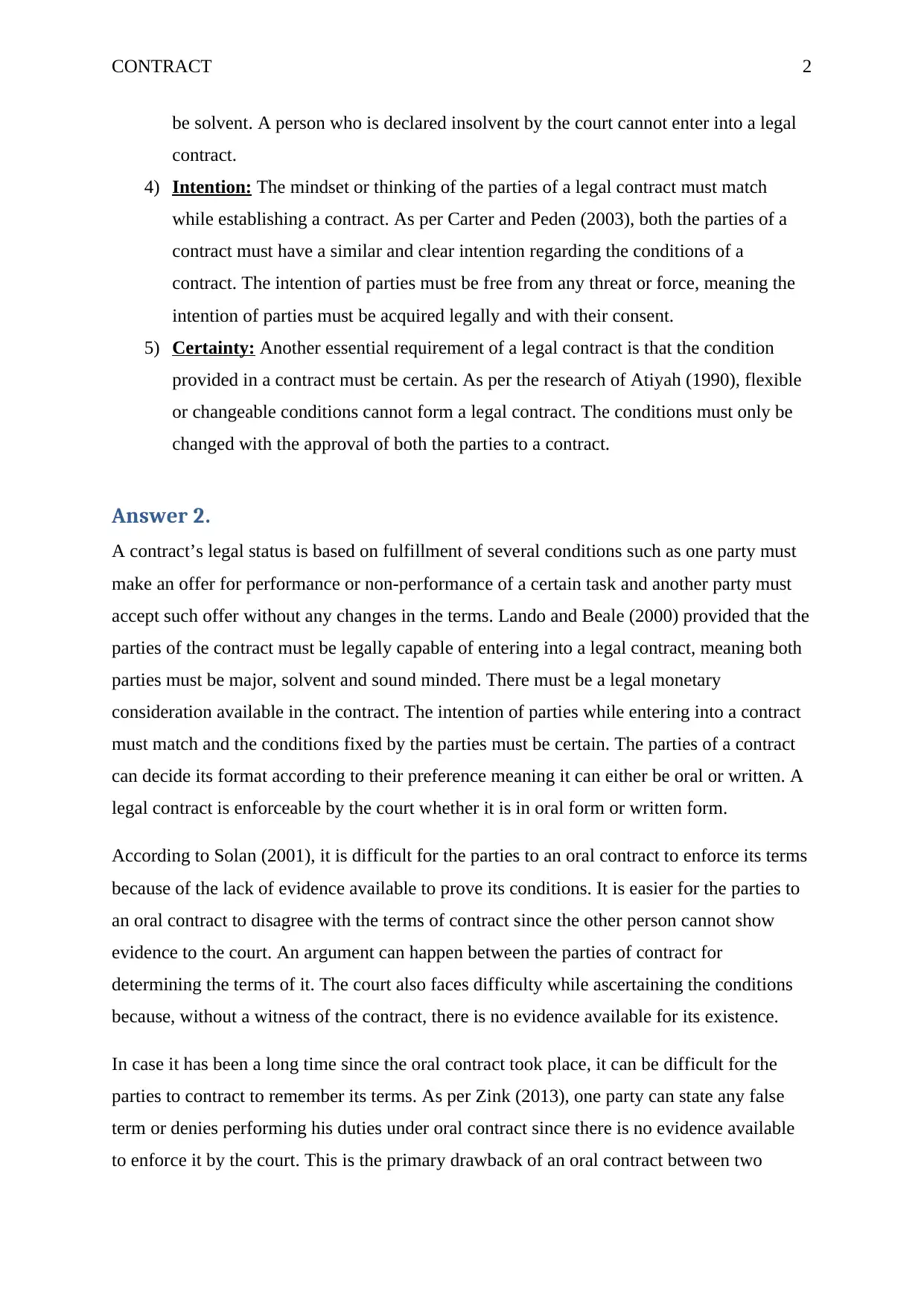
CONTRACT 2
be solvent. A person who is declared insolvent by the court cannot enter into a legal
contract.
4) Intention: The mindset or thinking of the parties of a legal contract must match
while establishing a contract. As per Carter and Peden (2003), both the parties of a
contract must have a similar and clear intention regarding the conditions of a
contract. The intention of parties must be free from any threat or force, meaning the
intention of parties must be acquired legally and with their consent.
5) Certainty: Another essential requirement of a legal contract is that the condition
provided in a contract must be certain. As per the research of Atiyah (1990), flexible
or changeable conditions cannot form a legal contract. The conditions must only be
changed with the approval of both the parties to a contract.
Answer 2.
A contract’s legal status is based on fulfillment of several conditions such as one party must
make an offer for performance or non-performance of a certain task and another party must
accept such offer without any changes in the terms. Lando and Beale (2000) provided that the
parties of the contract must be legally capable of entering into a legal contract, meaning both
parties must be major, solvent and sound minded. There must be a legal monetary
consideration available in the contract. The intention of parties while entering into a contract
must match and the conditions fixed by the parties must be certain. The parties of a contract
can decide its format according to their preference meaning it can either be oral or written. A
legal contract is enforceable by the court whether it is in oral form or written form.
According to Solan (2001), it is difficult for the parties to an oral contract to enforce its terms
because of the lack of evidence available to prove its conditions. It is easier for the parties to
an oral contract to disagree with the terms of contract since the other person cannot show
evidence to the court. An argument can happen between the parties of contract for
determining the terms of it. The court also faces difficulty while ascertaining the conditions
because, without a witness of the contract, there is no evidence available for its existence.
In case it has been a long time since the oral contract took place, it can be difficult for the
parties to contract to remember its terms. As per Zink (2013), one party can state any false
term or denies performing his duties under oral contract since there is no evidence available
to enforce it by the court. This is the primary drawback of an oral contract between two
be solvent. A person who is declared insolvent by the court cannot enter into a legal
contract.
4) Intention: The mindset or thinking of the parties of a legal contract must match
while establishing a contract. As per Carter and Peden (2003), both the parties of a
contract must have a similar and clear intention regarding the conditions of a
contract. The intention of parties must be free from any threat or force, meaning the
intention of parties must be acquired legally and with their consent.
5) Certainty: Another essential requirement of a legal contract is that the condition
provided in a contract must be certain. As per the research of Atiyah (1990), flexible
or changeable conditions cannot form a legal contract. The conditions must only be
changed with the approval of both the parties to a contract.
Answer 2.
A contract’s legal status is based on fulfillment of several conditions such as one party must
make an offer for performance or non-performance of a certain task and another party must
accept such offer without any changes in the terms. Lando and Beale (2000) provided that the
parties of the contract must be legally capable of entering into a legal contract, meaning both
parties must be major, solvent and sound minded. There must be a legal monetary
consideration available in the contract. The intention of parties while entering into a contract
must match and the conditions fixed by the parties must be certain. The parties of a contract
can decide its format according to their preference meaning it can either be oral or written. A
legal contract is enforceable by the court whether it is in oral form or written form.
According to Solan (2001), it is difficult for the parties to an oral contract to enforce its terms
because of the lack of evidence available to prove its conditions. It is easier for the parties to
an oral contract to disagree with the terms of contract since the other person cannot show
evidence to the court. An argument can happen between the parties of contract for
determining the terms of it. The court also faces difficulty while ascertaining the conditions
because, without a witness of the contract, there is no evidence available for its existence.
In case it has been a long time since the oral contract took place, it can be difficult for the
parties to contract to remember its terms. As per Zink (2013), one party can state any false
term or denies performing his duties under oral contract since there is no evidence available
to enforce it by the court. This is the primary drawback of an oral contract between two
⊘ This is a preview!⊘
Do you want full access?
Subscribe today to unlock all pages.

Trusted by 1+ million students worldwide
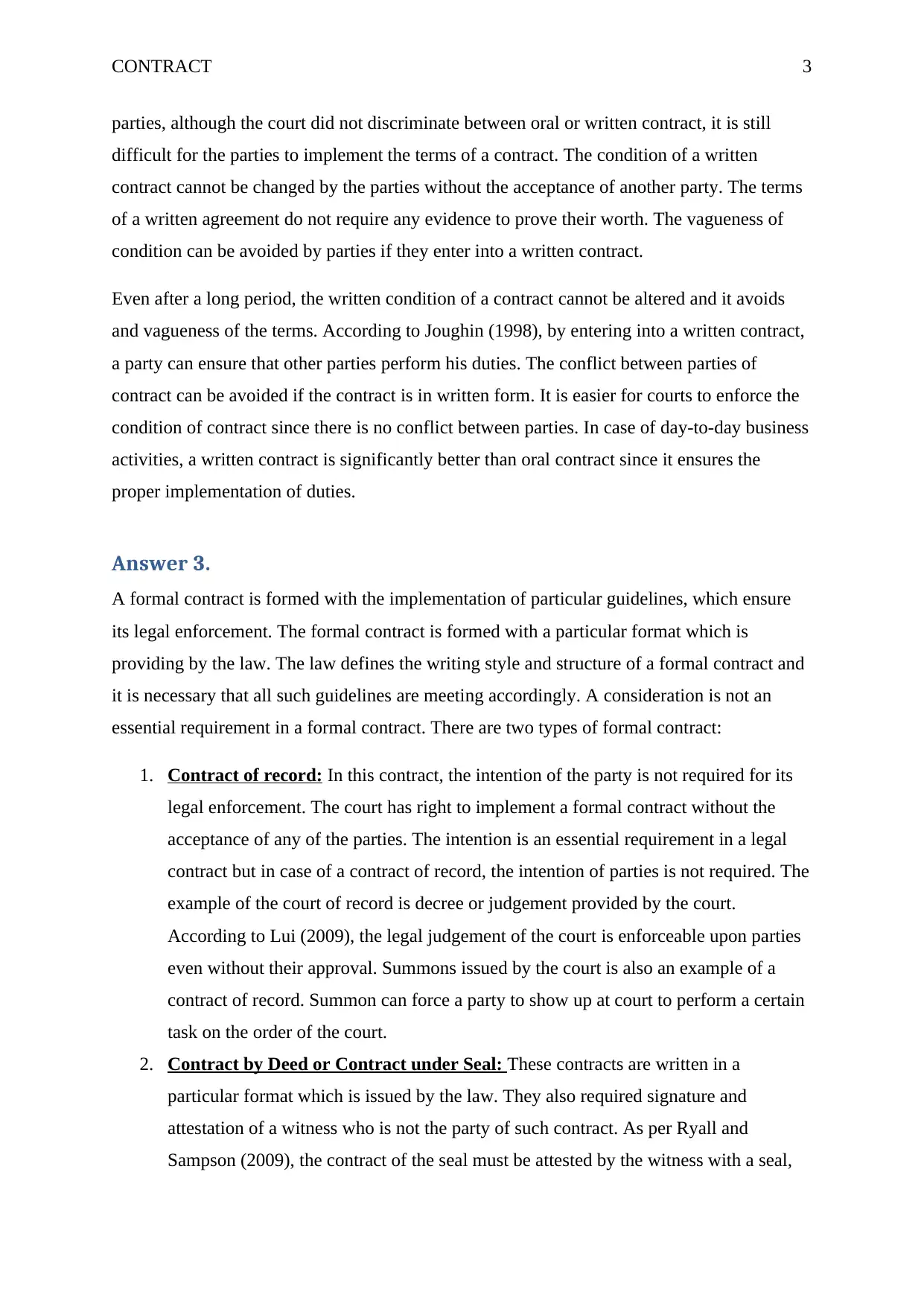
CONTRACT 3
parties, although the court did not discriminate between oral or written contract, it is still
difficult for the parties to implement the terms of a contract. The condition of a written
contract cannot be changed by the parties without the acceptance of another party. The terms
of a written agreement do not require any evidence to prove their worth. The vagueness of
condition can be avoided by parties if they enter into a written contract.
Even after a long period, the written condition of a contract cannot be altered and it avoids
and vagueness of the terms. According to Joughin (1998), by entering into a written contract,
a party can ensure that other parties perform his duties. The conflict between parties of
contract can be avoided if the contract is in written form. It is easier for courts to enforce the
condition of contract since there is no conflict between parties. In case of day-to-day business
activities, a written contract is significantly better than oral contract since it ensures the
proper implementation of duties.
Answer 3.
A formal contract is formed with the implementation of particular guidelines, which ensure
its legal enforcement. The formal contract is formed with a particular format which is
providing by the law. The law defines the writing style and structure of a formal contract and
it is necessary that all such guidelines are meeting accordingly. A consideration is not an
essential requirement in a formal contract. There are two types of formal contract:
1. Contract of record: In this contract, the intention of the party is not required for its
legal enforcement. The court has right to implement a formal contract without the
acceptance of any of the parties. The intention is an essential requirement in a legal
contract but in case of a contract of record, the intention of parties is not required. The
example of the court of record is decree or judgement provided by the court.
According to Lui (2009), the legal judgement of the court is enforceable upon parties
even without their approval. Summons issued by the court is also an example of a
contract of record. Summon can force a party to show up at court to perform a certain
task on the order of the court.
2. Contract by Deed or Contract under Seal: These contracts are written in a
particular format which is issued by the law. They also required signature and
attestation of a witness who is not the party of such contract. As per Ryall and
Sampson (2009), the contract of the seal must be attested by the witness with a seal,
parties, although the court did not discriminate between oral or written contract, it is still
difficult for the parties to implement the terms of a contract. The condition of a written
contract cannot be changed by the parties without the acceptance of another party. The terms
of a written agreement do not require any evidence to prove their worth. The vagueness of
condition can be avoided by parties if they enter into a written contract.
Even after a long period, the written condition of a contract cannot be altered and it avoids
and vagueness of the terms. According to Joughin (1998), by entering into a written contract,
a party can ensure that other parties perform his duties. The conflict between parties of
contract can be avoided if the contract is in written form. It is easier for courts to enforce the
condition of contract since there is no conflict between parties. In case of day-to-day business
activities, a written contract is significantly better than oral contract since it ensures the
proper implementation of duties.
Answer 3.
A formal contract is formed with the implementation of particular guidelines, which ensure
its legal enforcement. The formal contract is formed with a particular format which is
providing by the law. The law defines the writing style and structure of a formal contract and
it is necessary that all such guidelines are meeting accordingly. A consideration is not an
essential requirement in a formal contract. There are two types of formal contract:
1. Contract of record: In this contract, the intention of the party is not required for its
legal enforcement. The court has right to implement a formal contract without the
acceptance of any of the parties. The intention is an essential requirement in a legal
contract but in case of a contract of record, the intention of parties is not required. The
example of the court of record is decree or judgement provided by the court.
According to Lui (2009), the legal judgement of the court is enforceable upon parties
even without their approval. Summons issued by the court is also an example of a
contract of record. Summon can force a party to show up at court to perform a certain
task on the order of the court.
2. Contract by Deed or Contract under Seal: These contracts are written in a
particular format which is issued by the law. They also required signature and
attestation of a witness who is not the party of such contract. As per Ryall and
Sampson (2009), the contract of the seal must be attested by the witness with a seal,
Paraphrase This Document
Need a fresh take? Get an instant paraphrase of this document with our AI Paraphraser
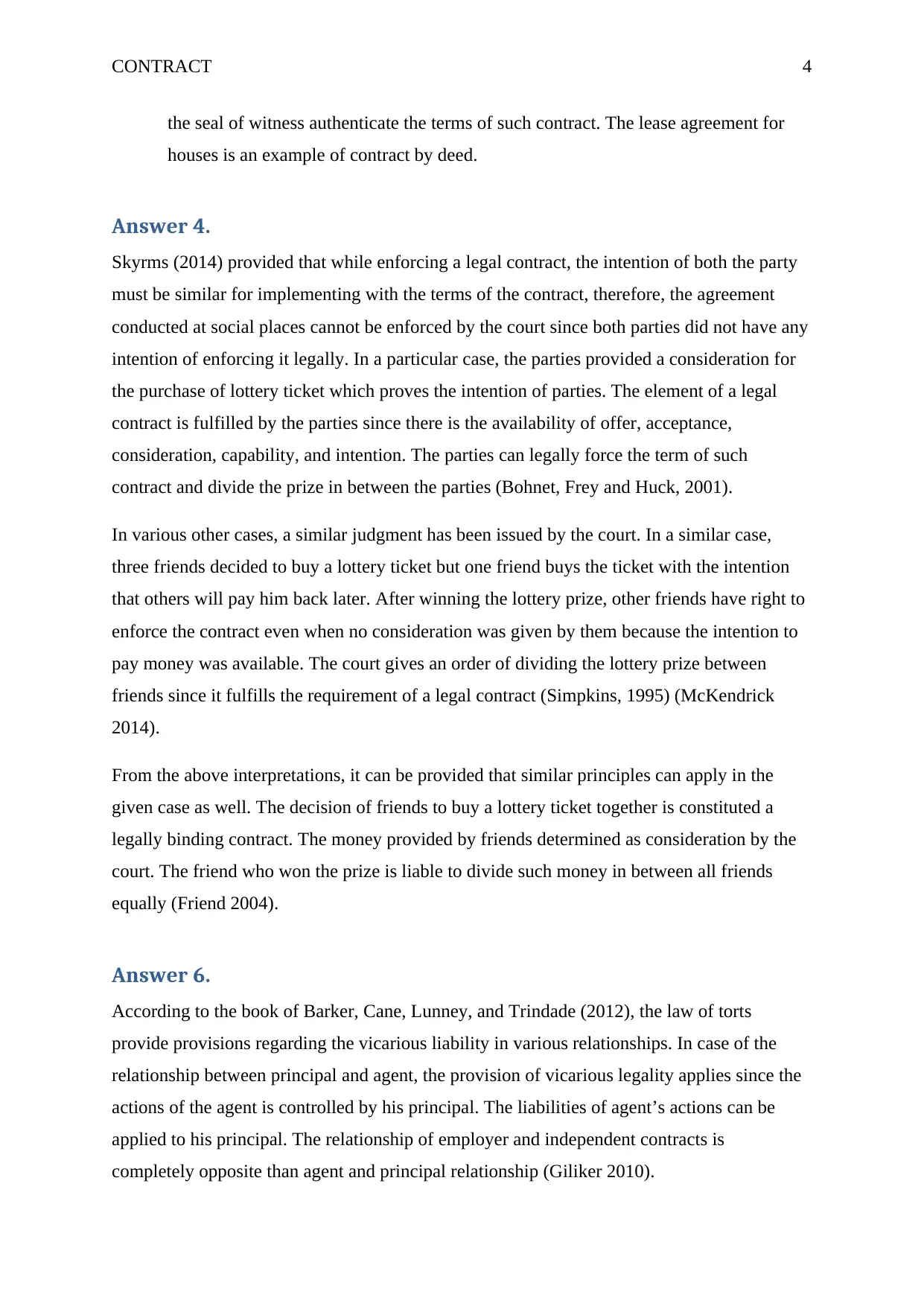
CONTRACT 4
the seal of witness authenticate the terms of such contract. The lease agreement for
houses is an example of contract by deed.
Answer 4.
Skyrms (2014) provided that while enforcing a legal contract, the intention of both the party
must be similar for implementing with the terms of the contract, therefore, the agreement
conducted at social places cannot be enforced by the court since both parties did not have any
intention of enforcing it legally. In a particular case, the parties provided a consideration for
the purchase of lottery ticket which proves the intention of parties. The element of a legal
contract is fulfilled by the parties since there is the availability of offer, acceptance,
consideration, capability, and intention. The parties can legally force the term of such
contract and divide the prize in between the parties (Bohnet, Frey and Huck, 2001).
In various other cases, a similar judgment has been issued by the court. In a similar case,
three friends decided to buy a lottery ticket but one friend buys the ticket with the intention
that others will pay him back later. After winning the lottery prize, other friends have right to
enforce the contract even when no consideration was given by them because the intention to
pay money was available. The court gives an order of dividing the lottery prize between
friends since it fulfills the requirement of a legal contract (Simpkins, 1995) (McKendrick
2014).
From the above interpretations, it can be provided that similar principles can apply in the
given case as well. The decision of friends to buy a lottery ticket together is constituted a
legally binding contract. The money provided by friends determined as consideration by the
court. The friend who won the prize is liable to divide such money in between all friends
equally (Friend 2004).
Answer 6.
According to the book of Barker, Cane, Lunney, and Trindade (2012), the law of torts
provide provisions regarding the vicarious liability in various relationships. In case of the
relationship between principal and agent, the provision of vicarious legality applies since the
actions of the agent is controlled by his principal. The liabilities of agent’s actions can be
applied to his principal. The relationship of employer and independent contracts is
completely opposite than agent and principal relationship (Giliker 2010).
the seal of witness authenticate the terms of such contract. The lease agreement for
houses is an example of contract by deed.
Answer 4.
Skyrms (2014) provided that while enforcing a legal contract, the intention of both the party
must be similar for implementing with the terms of the contract, therefore, the agreement
conducted at social places cannot be enforced by the court since both parties did not have any
intention of enforcing it legally. In a particular case, the parties provided a consideration for
the purchase of lottery ticket which proves the intention of parties. The element of a legal
contract is fulfilled by the parties since there is the availability of offer, acceptance,
consideration, capability, and intention. The parties can legally force the term of such
contract and divide the prize in between the parties (Bohnet, Frey and Huck, 2001).
In various other cases, a similar judgment has been issued by the court. In a similar case,
three friends decided to buy a lottery ticket but one friend buys the ticket with the intention
that others will pay him back later. After winning the lottery prize, other friends have right to
enforce the contract even when no consideration was given by them because the intention to
pay money was available. The court gives an order of dividing the lottery prize between
friends since it fulfills the requirement of a legal contract (Simpkins, 1995) (McKendrick
2014).
From the above interpretations, it can be provided that similar principles can apply in the
given case as well. The decision of friends to buy a lottery ticket together is constituted a
legally binding contract. The money provided by friends determined as consideration by the
court. The friend who won the prize is liable to divide such money in between all friends
equally (Friend 2004).
Answer 6.
According to the book of Barker, Cane, Lunney, and Trindade (2012), the law of torts
provide provisions regarding the vicarious liability in various relationships. In case of the
relationship between principal and agent, the provision of vicarious legality applies since the
actions of the agent is controlled by his principal. The liabilities of agent’s actions can be
applied to his principal. The relationship of employer and independent contracts is
completely opposite than agent and principal relationship (Giliker 2010).
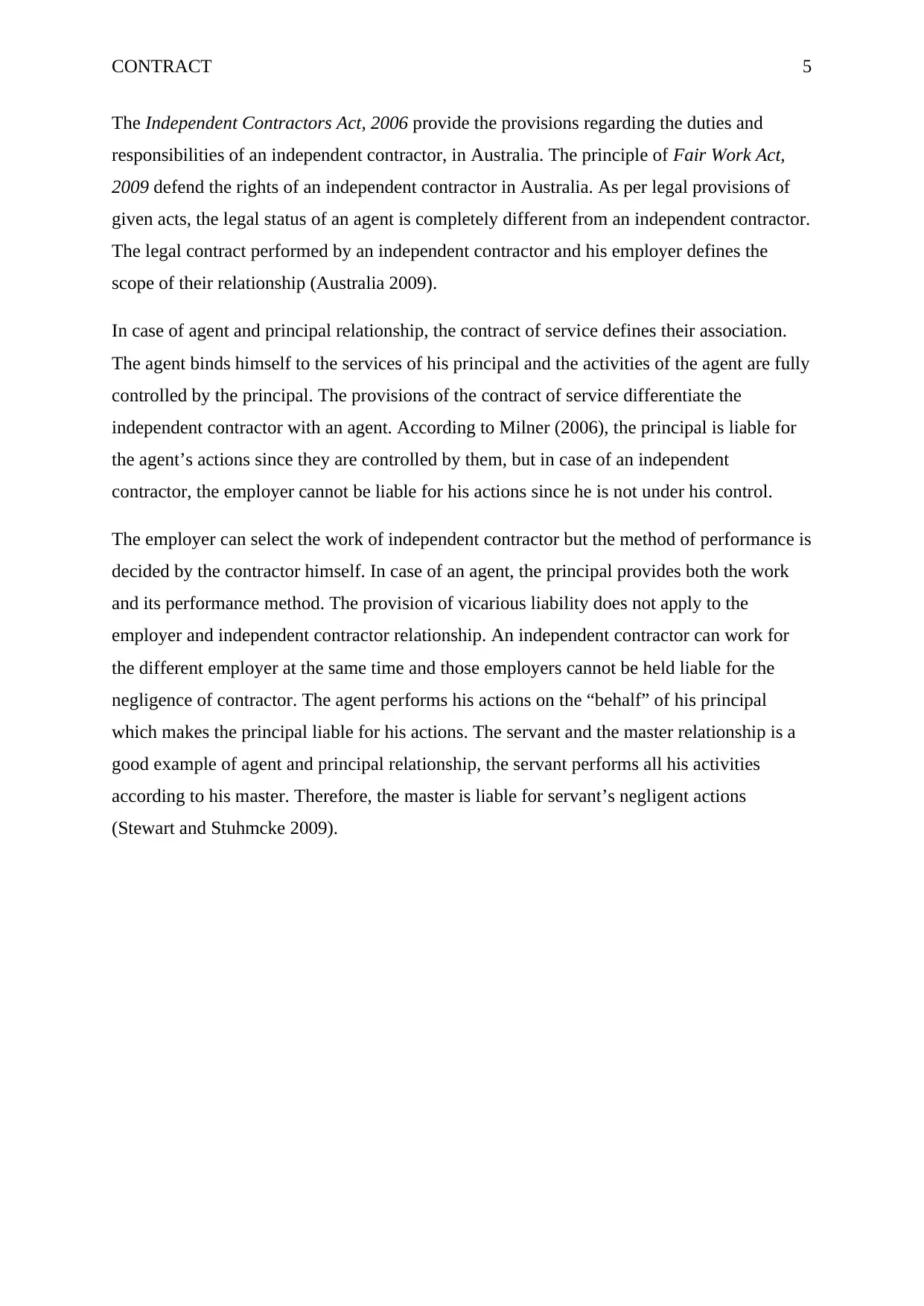
CONTRACT 5
The Independent Contractors Act, 2006 provide the provisions regarding the duties and
responsibilities of an independent contractor, in Australia. The principle of Fair Work Act,
2009 defend the rights of an independent contractor in Australia. As per legal provisions of
given acts, the legal status of an agent is completely different from an independent contractor.
The legal contract performed by an independent contractor and his employer defines the
scope of their relationship (Australia 2009).
In case of agent and principal relationship, the contract of service defines their association.
The agent binds himself to the services of his principal and the activities of the agent are fully
controlled by the principal. The provisions of the contract of service differentiate the
independent contractor with an agent. According to Milner (2006), the principal is liable for
the agent’s actions since they are controlled by them, but in case of an independent
contractor, the employer cannot be liable for his actions since he is not under his control.
The employer can select the work of independent contractor but the method of performance is
decided by the contractor himself. In case of an agent, the principal provides both the work
and its performance method. The provision of vicarious liability does not apply to the
employer and independent contractor relationship. An independent contractor can work for
the different employer at the same time and those employers cannot be held liable for the
negligence of contractor. The agent performs his actions on the “behalf” of his principal
which makes the principal liable for his actions. The servant and the master relationship is a
good example of agent and principal relationship, the servant performs all his activities
according to his master. Therefore, the master is liable for servant’s negligent actions
(Stewart and Stuhmcke 2009).
The Independent Contractors Act, 2006 provide the provisions regarding the duties and
responsibilities of an independent contractor, in Australia. The principle of Fair Work Act,
2009 defend the rights of an independent contractor in Australia. As per legal provisions of
given acts, the legal status of an agent is completely different from an independent contractor.
The legal contract performed by an independent contractor and his employer defines the
scope of their relationship (Australia 2009).
In case of agent and principal relationship, the contract of service defines their association.
The agent binds himself to the services of his principal and the activities of the agent are fully
controlled by the principal. The provisions of the contract of service differentiate the
independent contractor with an agent. According to Milner (2006), the principal is liable for
the agent’s actions since they are controlled by them, but in case of an independent
contractor, the employer cannot be liable for his actions since he is not under his control.
The employer can select the work of independent contractor but the method of performance is
decided by the contractor himself. In case of an agent, the principal provides both the work
and its performance method. The provision of vicarious liability does not apply to the
employer and independent contractor relationship. An independent contractor can work for
the different employer at the same time and those employers cannot be held liable for the
negligence of contractor. The agent performs his actions on the “behalf” of his principal
which makes the principal liable for his actions. The servant and the master relationship is a
good example of agent and principal relationship, the servant performs all his activities
according to his master. Therefore, the master is liable for servant’s negligent actions
(Stewart and Stuhmcke 2009).
⊘ This is a preview!⊘
Do you want full access?
Subscribe today to unlock all pages.

Trusted by 1+ million students worldwide
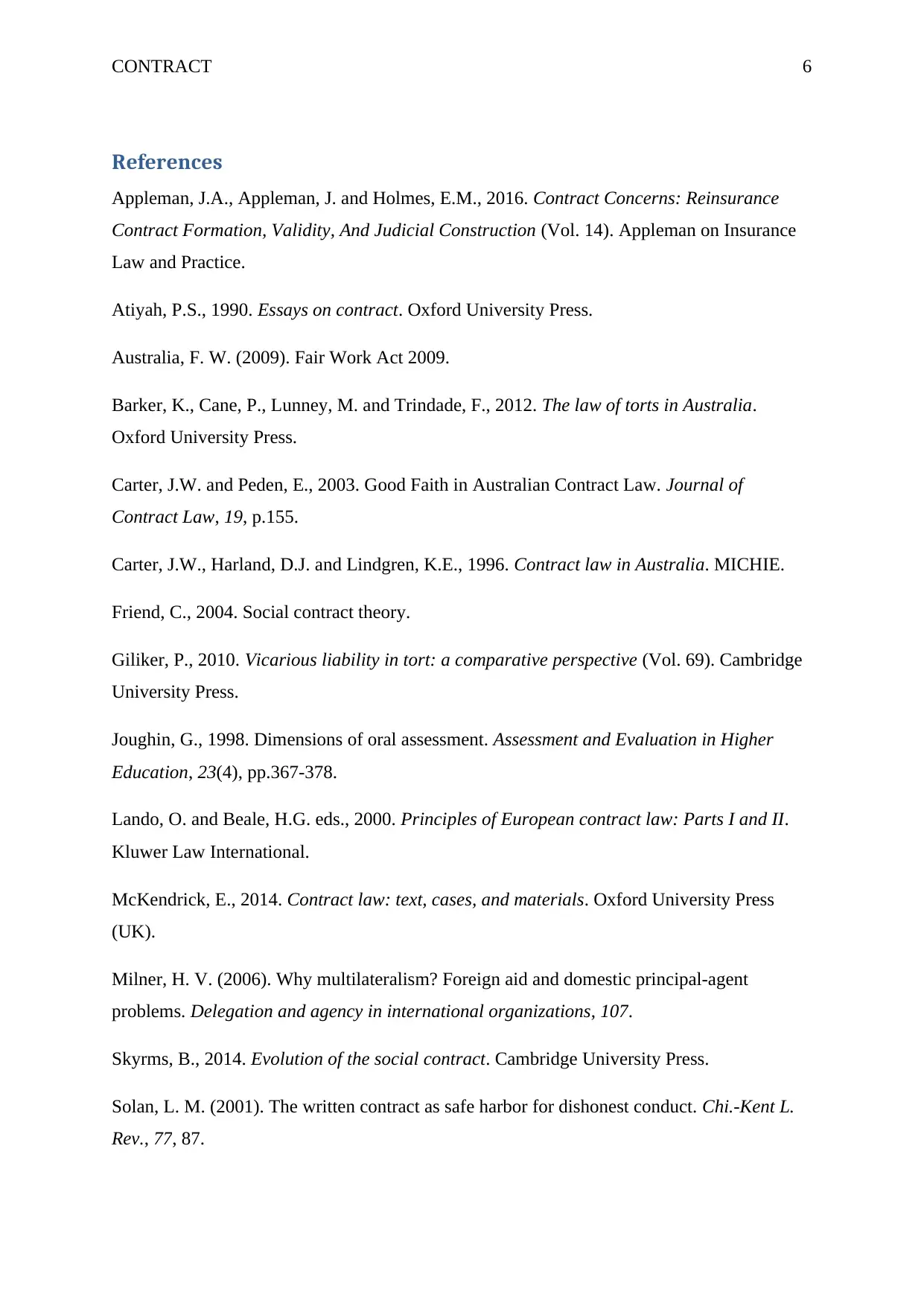
CONTRACT 6
References
Appleman, J.A., Appleman, J. and Holmes, E.M., 2016. Contract Concerns: Reinsurance
Contract Formation, Validity, And Judicial Construction (Vol. 14). Appleman on Insurance
Law and Practice.
Atiyah, P.S., 1990. Essays on contract. Oxford University Press.
Australia, F. W. (2009). Fair Work Act 2009.
Barker, K., Cane, P., Lunney, M. and Trindade, F., 2012. The law of torts in Australia.
Oxford University Press.
Carter, J.W. and Peden, E., 2003. Good Faith in Australian Contract Law. Journal of
Contract Law, 19, p.155.
Carter, J.W., Harland, D.J. and Lindgren, K.E., 1996. Contract law in Australia. MICHIE.
Friend, C., 2004. Social contract theory.
Giliker, P., 2010. Vicarious liability in tort: a comparative perspective (Vol. 69). Cambridge
University Press.
Joughin, G., 1998. Dimensions of oral assessment. Assessment and Evaluation in Higher
Education, 23(4), pp.367-378.
Lando, O. and Beale, H.G. eds., 2000. Principles of European contract law: Parts I and II.
Kluwer Law International.
McKendrick, E., 2014. Contract law: text, cases, and materials. Oxford University Press
(UK).
Milner, H. V. (2006). Why multilateralism? Foreign aid and domestic principal-agent
problems. Delegation and agency in international organizations, 107.
Skyrms, B., 2014. Evolution of the social contract. Cambridge University Press.
Solan, L. M. (2001). The written contract as safe harbor for dishonest conduct. Chi.-Kent L.
Rev., 77, 87.
References
Appleman, J.A., Appleman, J. and Holmes, E.M., 2016. Contract Concerns: Reinsurance
Contract Formation, Validity, And Judicial Construction (Vol. 14). Appleman on Insurance
Law and Practice.
Atiyah, P.S., 1990. Essays on contract. Oxford University Press.
Australia, F. W. (2009). Fair Work Act 2009.
Barker, K., Cane, P., Lunney, M. and Trindade, F., 2012. The law of torts in Australia.
Oxford University Press.
Carter, J.W. and Peden, E., 2003. Good Faith in Australian Contract Law. Journal of
Contract Law, 19, p.155.
Carter, J.W., Harland, D.J. and Lindgren, K.E., 1996. Contract law in Australia. MICHIE.
Friend, C., 2004. Social contract theory.
Giliker, P., 2010. Vicarious liability in tort: a comparative perspective (Vol. 69). Cambridge
University Press.
Joughin, G., 1998. Dimensions of oral assessment. Assessment and Evaluation in Higher
Education, 23(4), pp.367-378.
Lando, O. and Beale, H.G. eds., 2000. Principles of European contract law: Parts I and II.
Kluwer Law International.
McKendrick, E., 2014. Contract law: text, cases, and materials. Oxford University Press
(UK).
Milner, H. V. (2006). Why multilateralism? Foreign aid and domestic principal-agent
problems. Delegation and agency in international organizations, 107.
Skyrms, B., 2014. Evolution of the social contract. Cambridge University Press.
Solan, L. M. (2001). The written contract as safe harbor for dishonest conduct. Chi.-Kent L.
Rev., 77, 87.
Paraphrase This Document
Need a fresh take? Get an instant paraphrase of this document with our AI Paraphraser
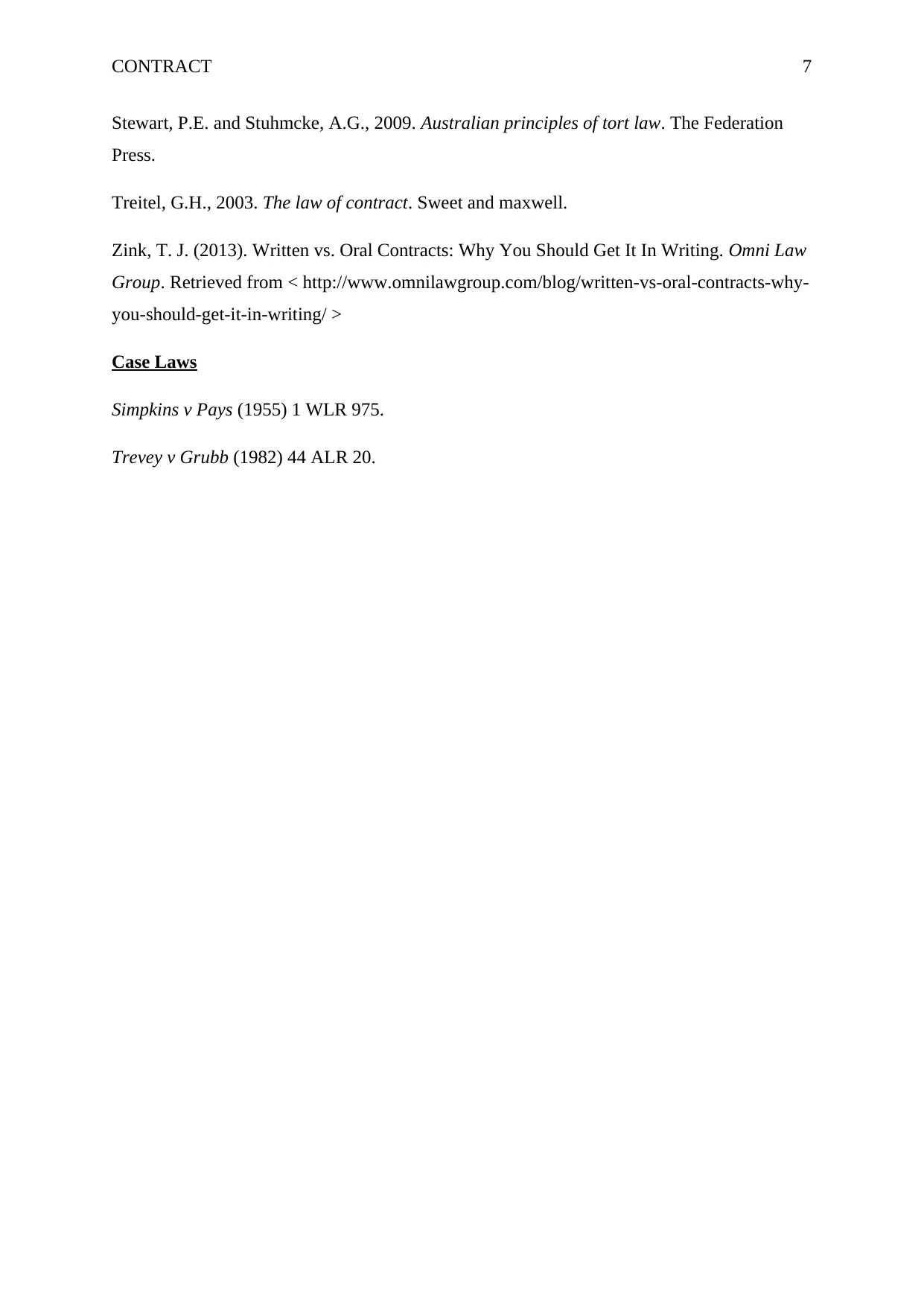
CONTRACT 7
Stewart, P.E. and Stuhmcke, A.G., 2009. Australian principles of tort law. The Federation
Press.
Treitel, G.H., 2003. The law of contract. Sweet and maxwell.
Zink, T. J. (2013). Written vs. Oral Contracts: Why You Should Get It In Writing. Omni Law
Group. Retrieved from < http://www.omnilawgroup.com/blog/written-vs-oral-contracts-why-
you-should-get-it-in-writing/ >
Case Laws
Simpkins v Pays (1955) 1 WLR 975.
Trevey v Grubb (1982) 44 ALR 20.
Stewart, P.E. and Stuhmcke, A.G., 2009. Australian principles of tort law. The Federation
Press.
Treitel, G.H., 2003. The law of contract. Sweet and maxwell.
Zink, T. J. (2013). Written vs. Oral Contracts: Why You Should Get It In Writing. Omni Law
Group. Retrieved from < http://www.omnilawgroup.com/blog/written-vs-oral-contracts-why-
you-should-get-it-in-writing/ >
Case Laws
Simpkins v Pays (1955) 1 WLR 975.
Trevey v Grubb (1982) 44 ALR 20.
1 out of 8
Related Documents
Your All-in-One AI-Powered Toolkit for Academic Success.
+13062052269
info@desklib.com
Available 24*7 on WhatsApp / Email
![[object Object]](/_next/static/media/star-bottom.7253800d.svg)
Unlock your academic potential
Copyright © 2020–2025 A2Z Services. All Rights Reserved. Developed and managed by ZUCOL.





